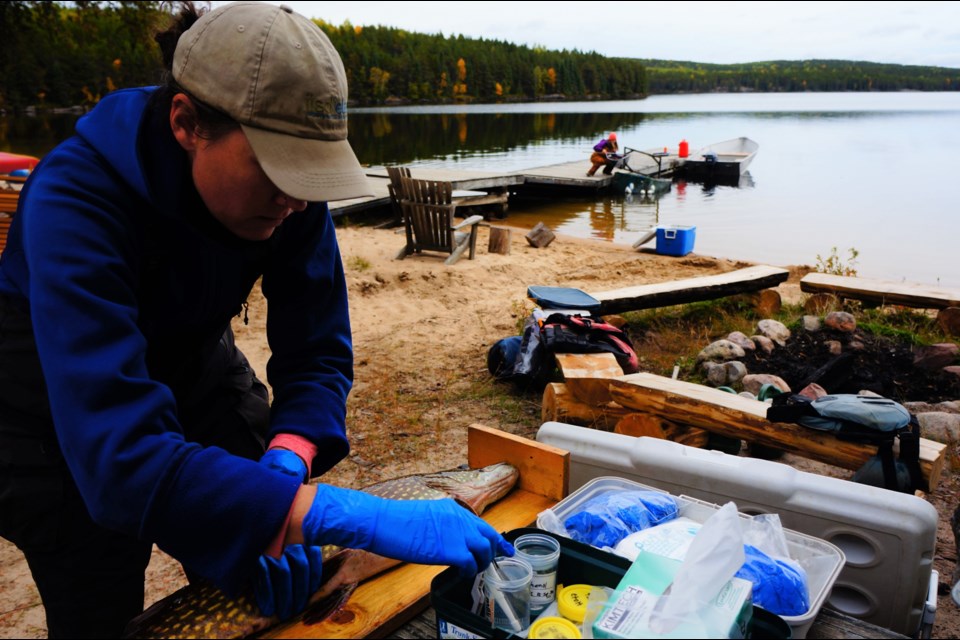The COVID-19 pandemic may have set back key projects at one of Canada’s most influential research facilities, but scientists at the Experimental Lakes Area (ELA) are counting their blessings as they look back at 2020.
Operated by the Winnipeg-based International Institute for Sustainable Development (IISD), the ELA encompasses 58 lakes in a remote stretch of northwestern Ontario about 50 kilometres east of Kenora.
It’s a unique facility, governed by special legislation that allows scientists to conduct experiments in real-world conditions. ELA research has made important contributions on issues including acid rain, algae blooms, and agricultural runoff since it opened in 1968, often informing government policy.
Deputy director Pauline Gerrard said the IISD team was happy to get through 2020 without breaking a 52-year chain of data on essential background information like water chemistry, insect and fish populations, and hydrology in ELA lakes.
“You can’t get that back,” she said.
The facility, which normally welcomes up to 65 people a day during the summer and includes labs, a workshop, dining hall, and living quarters, ran on a skeleton crew this year.
In March, the team decided against starting any new projects. Major studies on issues like the impact of oil spills and microplastics on freshwater systems were put on hold to minimize the number of researchers on site.
“We’re a very small community – we have a shared kitchen where everybody eats together, dorm-style accommodations where people are living in very close contact,” Gerrard explained. “We realized if COVID comes in, it’ll probably move through very quickly.”
Health concerns, and fears a shutdown would mean a year of lost data, led the IISD to take a “small cohort” approach, with field teams self-isolating before travelling to the facility.
Gerrard herself, who usually spends a large chunk of the summer on site, stayed put in Winnipeg.
The solution was successful in capturing essential background data, albeit at slightly lower frequencies than normal, but it did see projects with major implications set back by at least a year.
Lakehead University biology professor Michael Rennie is a lead researcher on the now-delayed microplastics experiment.
Dubbed the pELAstic project, it examines the alarming prevalence and uncertain impact of plastic particles in freshwater systems. The work takes place as governments around the world – including Canada’s – grapple with how to address the issue.
Researchers and government agencies on both sides of the Canada-U.S. border are involved with the project.
While there’s a need for better understanding and action on microplastics, Rennie said a pandemic delay of one to two years isn't a fatal blow.
“There’s a need for policy as soon as we can generate it around these substances,” he said. “There’s only so much you can do during a pandemic, though.
“It’s fair to say we’ve got at least a one-year delay, but whole-lake experiments aren’t conducted in a year. These are often half-decade to multi-decade experiments, so in the grand scheme of things, it’s not a deal-breaker.”
A Canada Research Chair in Freshwater Ecology and Fisheries at Lakehead, Rennie was hired at the ELA in 2010, before it was transferred from the federal government to the IISD in 2014.
“As far as I was concerned, I’d won the job lottery,” he said. “Where else do you get to spend a career doing whole-lake experiments like that? It’s one of the only facilities in the world where you can manipulate an entire ecosystem.”
“What you learn in a lab experiment often doesn’t translate to the real world. I think that’s been demonstrated time and time again in our work with nutrients, with acid rain, with synthetic estrogen."
Rennie’s interest in microplastics was piqued by a 2013 study that found surprisingly high levels in the Great Lakes, which inspired him to conduct similar tests in Lake Winnipeg.
“Lake Winnipeg is pretty remote – Gimli is the major centre,” he said. “What we were finding was that concentrations in Lake Winnipeg were comparable to Lake Erie, which has, like, 12 million people in the watershed.”
In 2019, researchers surveyed several ELA lakes to measure background levels of microplastics. Initial results look similar to those in Lake Winnipeg, Rennie said.
“There’s microplastic contamination in these lakes that are in the middle of nowhere – it speaks to this issue that, no matter where we look for microplastics, we keep finding them.”
The inescapable conclusion, he believes, is that much of the plastic found in water systems is deposited there through the atmosphere.
“While we’re still trying to measure that, there’s not a whole lot of other options,” he said. “We’re nearly 100 kilometres away from any major centre, and yet we’re finding these fibres. And we know from previous work that we do see atmospheric transport of microplastics.”
Researchers had planned smaller experiments in ELA lakes using enclosures known as mesocosms in 2020, adding plastics at different concentrations and monitoring the effects on indicators like nutrient levels, algae and zooplankton, and fish – as well as amphibians and benthic invertebrates, using near-shore mesocosms.
Some of those experiments could go forward in 2021, depending on pandemic conditions. A tentative goal to begin whole-lake experiments by 2022 is now uncertain, however.
As it considers its 2021 plans, the IISD is also launching a fundraising campaign it hopes will allow it to do more work under COVID-19 restrictions. The purchase of additional equipment would allow its chemistry lab to operate with fewer people working in close proximity, Gerrard said.
Mostly, though, she’s simply grateful researchers were able to avoid major setbacks while staying safe.
“We managed to maintain the work all summer in a very safe way, and I’m just super proud of everybody that was part of making that happen,” she said.
– TBNewsWatch




